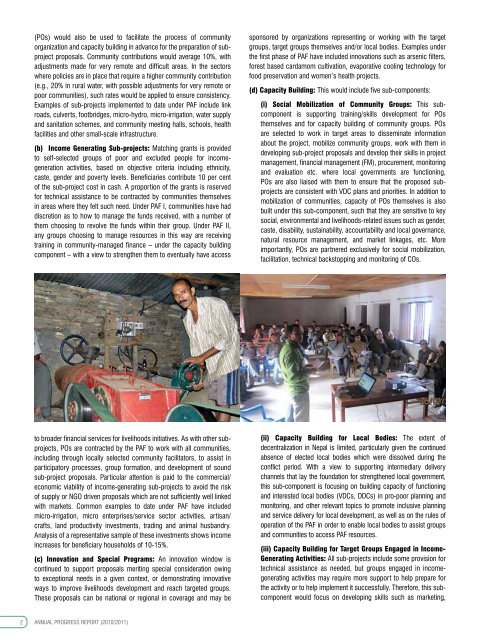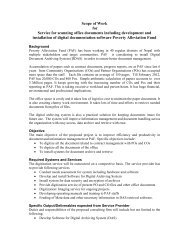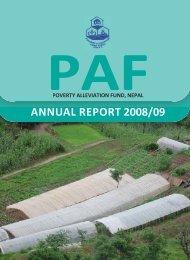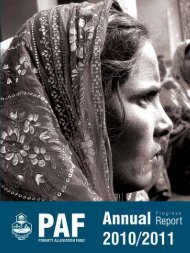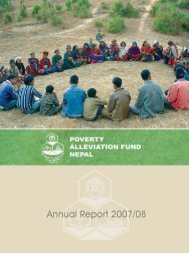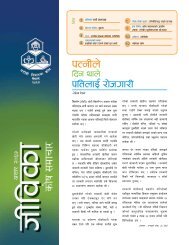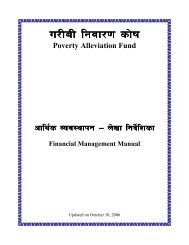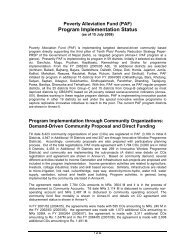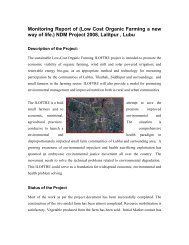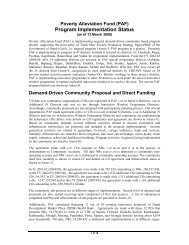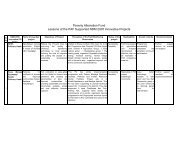Fiscal year 2010/11 - Poverty Alleviation Fund, Nepal
Fiscal year 2010/11 - Poverty Alleviation Fund, Nepal
Fiscal year 2010/11 - Poverty Alleviation Fund, Nepal
You also want an ePaper? Increase the reach of your titles
YUMPU automatically turns print PDFs into web optimized ePapers that Google loves.
(POs) would also be used to facilitate the process of community<br />
organization and capacity building in advance for the preparation of subproject<br />
proposals. Community contributions would average 10%, with<br />
adjustments made for very remote and difficult areas. In the sectors<br />
where policies are in place that require a higher community contribution<br />
(e.g., 20% in rural water, with possible adjustments for very remote or<br />
poor communities), such rates would be applied to ensure consistency.<br />
Examples of sub-projects implemented to date under PAF include link<br />
roads, culverts, footbridges, micro-hydro, micro-irrigation, water supply<br />
and sanitation schemes, and community meeting halls, schools, health<br />
facilities and other small-scale infrastructure.<br />
(b) Income Generating Sub-projects: Matching grants is provided<br />
to self-selected groups of poor and excluded people for incomegeneration<br />
activities, based on objective criteria including ethnicity,<br />
caste, gender and poverty levels. Beneficiaries contribute 10 per cent<br />
of the sub-project cost in cash. A proportion of the grants is reserved<br />
for technical assistance to be contracted by communities themselves<br />
in areas where they felt such need. Under PAF I, communities have had<br />
discretion as to how to manage the funds received, with a number of<br />
them choosing to revolve the funds within their group. Under PAF II,<br />
any groups choosing to manage resources in this way are receiving<br />
training in community-managed finance – under the capacity building<br />
component – with a view to strengthen them to eventually have access<br />
sponsored by organizations representing or working with the target<br />
groups, target groups themselves and/or local bodies. Examples under<br />
the first phase of PAF have included innovations such as arsenic filters,<br />
forest based cardamom cultivation, evaporative cooling technology for<br />
food preservation and women’s health projects.<br />
(d) Capacity Building: This would include five sub-components:<br />
(i) Social Mobilization of Community Groups: This subcomponent<br />
is supporting training/skills development for POs<br />
themselves and for capacity building of community groups. POs<br />
are selected to work in target areas to disseminate information<br />
about the project, mobilize community groups, work with them in<br />
developing sub-project proposals and develop their skills in project<br />
management, financial management (FM), procurement, monitoring<br />
and evaluation etc. where local governments are functioning,<br />
POs are also liaised with them to ensure that the proposed subprojects<br />
are consistent with VDC plans and priorities. In addition to<br />
mobilization of communities, capacity of POs themselves is also<br />
built under this sub-component, such that they are sensitive to key<br />
social, environmental and livelihoods-related issues such as gender,<br />
caste, disability, sustainability, accountability and local governance,<br />
natural resource management, and market linkages, etc. More<br />
importantly, POs are partnered exclusively for social mobilization,<br />
facilitation, technical backstopping and monitoring of COs.<br />
to broader financial services for livelihoods initiatives. As with other subprojects,<br />
POs are contracted by the PAF to work with all communities,<br />
including through locally selected community facilitators, to assist in<br />
participatory processes, group formation, and development of sound<br />
sub-project proposals. Particular attention is paid to the commercial/<br />
economic viability of income-generating sub-projects to avoid the risk<br />
of supply or NGO driven proposals which are not sufficiently well linked<br />
with markets. Common examples to date under PAF have included<br />
micro-irrigation, micro enterprises/service sector activities, artisan/<br />
crafts, land productivity investments, trading and animal husbandry.<br />
Analysis of a representative sample of these investments shows income<br />
increases for beneficiary households of 10-15%.<br />
(c) Innovation and Special Programs: An innovation window is<br />
continued to support proposals meriting special consideration owing<br />
to exceptional needs in a given context, or demonstrating innovative<br />
ways to improve livelihoods development and reach targeted groups.<br />
These proposals can be national or regional in coverage and may be<br />
(ii) Capacity Building for Local Bodies: The extent of<br />
decentralization in <strong>Nepal</strong> is limited, particularly given the continued<br />
absence of elected local bodies which were dissolved during the<br />
conflict period. With a view to supporting intermediary delivery<br />
channels that lay the foundation for strengthened local government,<br />
this sub-component is focusing on building capacity of functioning<br />
and interested local bodies (VDCs, DDCs) in pro-poor planning and<br />
monitoring, and other relevant topics to promote inclusive planning<br />
and service delivery for local development, as well as on the rules of<br />
operation of the PAF in order to enable local bodies to assist groups<br />
and communities to access PAF resources.<br />
(iii) Capacity Building for Target Groups Engaged in Income-<br />
Generating Activities: All sub-projects include some provision for<br />
technical assistance as needed, but groups engaged in incomegenerating<br />
activities may require more support to help prepare for<br />
the activity or to help implement it successfully. Therefore, this subcomponent<br />
would focus on developing skills such as marketing,<br />
2 ANNUAL PROGRESS REPORT (<strong>2010</strong>/20<strong>11</strong>)


